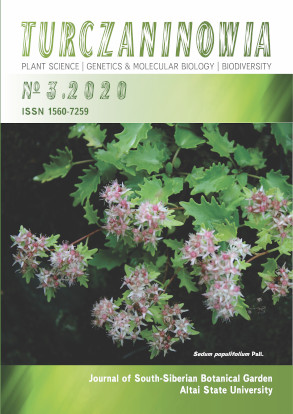Addition to the flora of Altai (Oxytropis DC.). I
Abstract
Revision of herbarium material stored in the Herbarium of Altai State University (ALTB, Barnaul) resulted in revealing new localities of the following six species of Oxytropis DC.: O. saposhnikovii Kryl., O. longibracteata Kar. et Kir., O. martjanovii Kryl., O. kusnetzovii Kryl. et Steinb., O. ladyginii Kryl., O. lapponica (Wahl.) Ј. Gay. Two of them (O. longibracteata and O. martjanovii) were not previously reported for the flora of Ukok Plateau. For O. saposhnikovii, occurence in Kazakhstan is proved.
Downloads
Metrics
References
Chinese Virtual Herbarium (CVH). URL: http://www.cvh.ac.cn/en/list?key=oxytropis%2520saposhnikovii&n=1
Дьяченко С. А. Флора плоскогорья Укок и ее охрана: дисс. ... канд. биол. наук. Барнаул, 2000. 172 с.
GBIF. URL: https://www.gbif.org/occurrence/gallery?taxon_key=5361614
Грубов В. И. Род Остролодочник // Растения Центральной Азии. По материалам Ботанического института им. В. Л. Комарова. Вып. 8б. СПб.: Изд-во СПХФА, «Мир и Семья-95», 1998. 89 с.
Губанов И. А. Конспект флоры Внешней Монголии (сосудистые растения) / Под ред. Р. В. Камелина. М.: Валанг, 1996. 136 с.
International Legume Database and Information Service. URL: https://ildis.org/cgi-bin/Araneus.pl?version~10.01&LegumeWeb&tno~25959&genus~Oxytropis&species~saposhnikovii
Крылов П. Н. Род Oxytropis // Флора Западной Сибири. Т. 7. Томск, 1933. С. 1713–1766.
Малышев Л. И. Разнообразие рода остролодка (Oxytropis) в Азиатской России // Turczaninowia, 2008, Т. 11, № 3. С. 5–141.
Манеев А. Г. Конспект флоры хребта Чихачева (Юго-Восточный Алтай) / Новое о флоре Сибири. Новосибирск: Наука, 1986. С. 86–136.
Положий А. В. Oxytropis DC. – Остролодочник // Флора Сибири. Т. IX. Новосибирск: Сибирская издательская фирма «Наука», 1994. С. 74–150.
Положий А. В., Шауло Д. Н. Fabaceae (Leguminosae) – Бобовые // Определитель растений Республики Тывы / Под ред. Д. Н. Шауло. Новосибирск: Изд-во Сиб. отд. РАН, 2007. С. 296–340.
Pyak A. I., Shaw S. C., Ebel A. L., Zverev A. A., Hodgson J. G., Wheeler B. D., Gaston K. J., Morenko M. O., Revushkin A. S., Kotukhov Yu. A., Oyunchimeg D. 2008. Endemic plants of the Altai mountain country. Old Basing: Wild Guides. 368 pp.
Рудая Н. А. Новый вид для флоры Алтая – Oxytropis longibracteata Kar. et Kir. (Fabaceae) // Turczaninowia, 2001. Т. 4, № 3. С. 39–41.
Серегин А. П. (ред.) Цифровой гербарий МГУ. М.: МГУ, 2020. URL: https://plant.depo.msu.ru/open/public/search?searchBy=any&queryString=oxytropis%20saposhnikovii (дата обращения 30.01.2020).
Шауло Д. Н., Артемов И. А., Додук А. Д., Молокова Н. И. Флористические находки в Республике Тыва // Turczaninowia, 2006, Т. 9, № 3. С. 90–98.
Васильченко И. Т., Федченко Б. А. Род Остролодочник – Oxytropis DC. // Флора СССР. Т. XIII. Отв. ред. В. Л. Комаров. Л.: Изд-во АН СССР, 1948. С. 1–229.
Turczaninowia is a golden publisher, as we allow self-archiving, but most importantly we are fully transparent about your rights.
Authors may present and discuss their findings ahead of publication: at biological or scientific conferences, on preprint servers, in public databases, and in blogs, wikis, tweets, and other informal communication channels.
Turczaninowia allows authors to deposit manuscripts (currently under review or those for intended submission to Turczaninowia) in non-commercial, pre-print servers such as ArXiv.
Authors who publish with this journal agree to the following terms:
- Authors retain copyright and grant the journal right of first publication with the work simultaneously licensed under a Creative Commons Attribution License that allows others to share the work with an acknowledgement of the work's authorship and initial publication in this journal.
- Authors are able to enter into separate, additional contractual arrangements for the non-exclusive distribution of the journal's published version of the work (e.g., post it to an institutional repository or publish it in a book), with an acknowledgement of its initial publication in this journal.
- Authors are permitted and encouraged to post their work online (e.g., in institutional repositories or on their website) prior to and during the submission process, as it can lead to productive exchanges, as well as earlier and greater citation of published work (See The Effect of Open Access).





